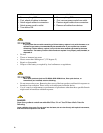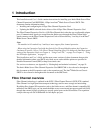
2 Intel® Blade Server Fibre Channel Expansion Card SBEFCM4, 4 Gbps: Installation and User’s Guide
Related documentation
This Installation and User’s Guide contains setup and installation instructions for your expansion
card, including information about getting started and how to configure your expansion card.
In addition to this Installation and User’s Guide, see the related documentation on the following
Resource CDs:
• Brocade* Enterprise and Entry SAN Switch Module SBCEBFCSW \ SBCEBFCESW
Resource CD
• Brocade* 4 Gb SAN Switch Module Resource CD
Features and specifications
The 4 Gb Fibre Channel Expansion Card has the following features:
• Compliance with U.S. and international safety and emissions standards
• Support for direct memory access (DMA)
• Support for bus mastering
• Fast!UTIL basic input/output system (BIOS) utility program to customize the configuration
parameters on the Expansion Card and attached drives
• Support for Fibre Channel protocol SCSI (FCP-SCSI) and Fibre Channel Internet protocol
(FCP-IP)
• Support for point-to-point fabric connection (F-port fabric login)
• Support for Fibre Channel service (classes 2 and 3)
The Fibre Channel Expansion Card has the following specifications:
Table 1. Fibre Channel Expansion Card specifications
Type Specification
Fibre Channel specifications • Bandwidth: 4 Gb per second maximum at half-duplex and 8 Gb
per second maximum at full-duplex per port
• Support for both FCP-SCSI and IP protocols
• Support for point-to-point fabric connection: F-Port Fabric
Login
• Support for FCAL public loop profile: FL-Port Login
• Support for Fibre Channel services class 2 and 3
• Support for FCP SCSI initiator and target operation
• Support for full-duplex operation
• Copper interface ac coupled
Processor Single-chip design with two completely independent 4 Gb serial
Fibre Channel ports. Each port provides:
• RISC processor
• Integrated serializer/deserializer
• Receive direct memory access (DMA) sequencer
•Frame buffer
• Five-channel DMA controller
Host data transfer 64-bit, 100 MHz bus-master DMA data transfers to 800 MB per
second
RAM 512 KB sync burst SRAM per channel supporting parity protection


















